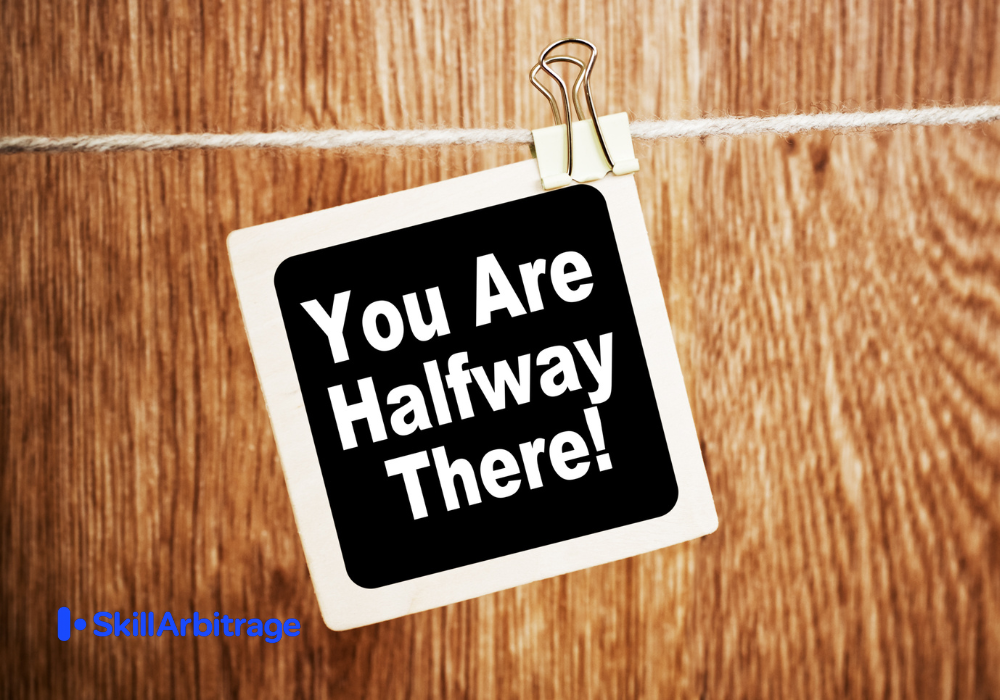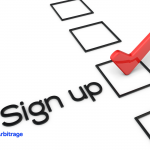This article talks in detail about the endowed progress effect in content. The tips, templates, and hacks will be useful for content writers, marketers, and strategists who want to boost conversions and retention by using the endowed progress effort.
Table of Contents
Introduction
Every year around January, when the New Year’s resolutions are still fresh, I have an intense urge to join the gym. But my prior experience tells me that I should not. I would probably go for three days and then give up.
This year, however, I was more determined than ever to keep at it, but the old patterns soon resurfaced. After diligently attending all sessions for a month, I missed a session one morning in March and then missed another one soon, for some other reason. Soon, I was back to the much-dreaded, familiar position, I was about to give up.
But then something unusual happened. The Gym sent me an email.
“You are already halfway there! Don’t give up now!”
And suddenly, I did not want to give up. It did not seem like I wasn’t making any progress; it did not seem like all was lost.
Instead, it felt like the few missed sessions were a minor setback, and the next day I was back in the gym. You must have had similar experiences as well.
Imagine this.
You sign up for a career platform just to explore. You answer one question, “What’s your current job title?”, and suddenly the screen flashes:
“Step 1 of 3 Complete
Next: Choose your dream job.”
You weren’t planning to do much.
But now, with one small action, you’ve started a journey. You are 33% in.
And that’s when the shift happens.
You feel the momentum.
You feel progress.
You want to finish.
That’s the endowed progress effect at play.
If you’re a marketer or copywriter looking to boost conversions, this psychological trick is your secret weapon. By showing users they’ve already made progress, you can turn drop-offs into completions. Let’s explore how this works, why it’s so effective, and how you can use it in your funnels, emails, and onboarding flows
Let’s dive in.
What is the endowed progress effect?
Coined by researchers Joseph Nunes and Xavier Dreze, the Endowed Progress Effect says:
“People are more likely to complete a task when they believe they’ve already made progress toward it.”
This isn’t simple optimism, it’s cognitive bias at work.
The moment we’re told we’re “30% done,” we feel like we’ve invested effort — even if the first step was trivial. That sense of momentum makes us far more likely to finish what we started.
Here’s a closer look at the benefits of using this technique.
The psychological triggers behind the retention
The endowed progress effect is the cumulative effect of four main psychological triggers.
- Commitment bias: People are more motivated to complete tasks once they have made a commitment. After that, they are more likely to continue due to a need for consistency.
- Loss aversion: If a user feels like they’re already partway through, dropping off feels like losing progress.
- Effort justification: We value outcomes more when we’ve already made an effort, even a small one.
- Completion bias: Humans love crossing things off. The closer you make the finish line feel, the more people chase it.
You have seen the endowment effect at work in various places, even if this is the first time you are coming across the term.
Examples of endowed progress effect
1. Gym apps creating urgency
Remember my experience at the gym? Sometimes people drop off because they lack motivation. A simple nudge, reminding them what they have already achieved, is a great way to bring them back.
Copy: “3 of 12 workouts completed. Keep going — you are on a roll!”
Why it works: By acknowledging your completed sessions, the app triggers the effort justification process. Users think: “I’ve already shown up 3 times. Can’t let that go to waste.”
You can also use a visual progress bar to create urgency, just 9 more to reach the milestone.
2. Ed-Techs using loss aversion
Students may sign up for an online course and then drop off mid-way. They need to be reminded that their effort would be completely wasted if they don’t sign up.
Copy: “You’ve completed 1 of 5 modules. Continue learning to boost your exam score.”
Why it works: This taps into loss aversion. If you quit now, you’ve “wasted” your effort. It also feeds completion bias. It is a feasible step as well, a neat 5-step module feels conquerable, not overwhelming.
3. Career counselling platforms asking for micro-commitments
To stop people from leaving their profiles unfinished, ask for small commitments at each checkpoint. These commitments can be as simple as answering a question.
Copy: “Step 1 of 3: Profile Created. Next: Tell us your career goal.”
Why it works: In this technique, tiny commitments are needed at each step, instead of a big commitment later. Short funnels with clear checkpoints leverage micro-commitments. Once users do “Step 1”, skipping “Step 2” feels like leaving a story half-finished.
4. Job sites using anchoring and momentum
People often leave their profiles unfinished on job sites and other platforms. Telling them how far they have come and how easy it would be to complete the process is a good way to bring them back.
Copy (email): “You’re already 30% done with onboarding. Let’s finish the rest in just 2 steps.”
Why it works: It compresses the journey. Even if onboarding has 4–5 tasks, framing it as 30% done convinces users that the hard part is over. This approach uses anchoring (you are not starting from zero) + momentum framing.
What can you do to leverage this in your copy and keep the consumers from dropping off?
Follow these simple steps.
How to use the endowed progress effect
1. Step-based CTAs
Don’t make your CTA into a flat red box; make it an experience.
Flat: “Sign up for a free mock interview.”
Enhanced with endowed progress effect: “Step 2 of 3: Book your free mock interview. You have already uploaded your resume.”
It turns the CTA into a journey. Even skeptics are more likely to continue, not because they’re excited, but because they already feel committed .
2. Funnel drop-off recovery emails
Don’t just remind customers that they have dropped off, remind them how far they have come.
Flat: “Hey, you left your profile incomplete.”
Enhanced with endowed progress effect: “You’re halfway through your profile. Let’s finish and unlock personalized career tips.”
3. Email subject lines
Use the endowment progress effect in the subject line by highlighting the ease of completion and milestones the customer has already achieved.
Subject lines that convert:
- “Only 1 step left to get your free prep plan”
- “Your resume is ready. Let’s perfect it together (Step 2 of 3)”
- “50% done — unlock the rest of your roadmap”
Instead of guilt-tripping users, you use positive reinforcement and loss aversion. They don’t want to “lose” that 50% they already earned.
4. Onboarding copy that feels like progress
Craft your copy as if users are climbing a staircase, not running a marathon.
Example (Career Platform Onboarding):
- Day 1: “Welcome! You’ve unlocked Step 1: Your Profile is set up.”
- Day 2: “33% complete. Let’s identify your top career goals.”
- Day 3: “One step left to unlock your personalized success roadmap.”
Every message reinforces: “You’re in motion. You’re succeeding. You just need to keep going.”
Now, let’s see how to craft a complete funnel based on this principle.
Funnel copy template: 3-step progress-based journey to retain users
Let’s say you’re writing for a career coaching funnel. Use this framework:
Step 1: Low barrier entry
Copy: “Let’s begin!
Step 1: Tell us your current job title.”
Why this works: It’s frictionless. The user isn’t asked for commitment, just a piece of info.
Step 2: Identity activation
Copy: “Great start!
Step 2 of 3: Choose your career goals.”
Why this works: By Step 2, you’re engaging the consumer’s aspirations. This builds identity alignment they start seeing themselves in the role they want.
Step 3: Conversion
Copy: “You are just one step away from your personalized strategy call.
Steps 1 & 2 completed.
Let’s book your free call now.”
Why this works: The user now has sunk cost (time + mental effort), momentum, and clarity, the golden trio for conversion.
Here’s how to use the effect in any funnel.
Bonus hack: “Fake progress” works too
Sometimes, you can show progress without making the customer work at all. This was proved beyond doubt recently.
In a famous study, researchers gave loyalty cards to a car wash.
- Group A: Buy 8, get 1 free
- Group B: Buy 10, get 1 free — but 2 stamps were pre-filled
It was seen that Group B had almost double the completion rate.
Why? Pre-filled progress feels earned, even if it’s artificial.
You can replicate this by auto-completing Step 1 (“Account Created”) in your app or funnel. This will make the users feel that they already have an advantage and drive conversions faster.
Conclusion
If you want people to finish what they start, don’t just remind them where they’re going, show them how far they’ve already come.
That’s the power of the endowed progress effect.
Whether you’re writing onboarding flows, CTAs, drop-off emails, or retention nudges, frame the journey as already in motion. Show progress. Celebrate small wins. Break big goals into tiny, visible steps.
Because once users feel they’ve started, they’re far more likely to finish.
Your job as a writer isn’t just to convert — it’s to create momentum.
So the next time you’re writing copy and wondering how to reduce drop-offs or increase action rates, ask yourself: “How can I show them they’re already making progress?”
You don’t need big promises or hard pushes.
Just one simple line: “You’re 30% done.”And that might be all it takes to get them to the finish line.
FAQs
1. Can I apply this even if my product isn’t a step-by-step journey?
Yes. Break down your process into micro-steps. For example, even “reading an article” can be Step 1. Use subtle checkpoints like “You’ve started learning X” or “Part 1 of your guide is complete.”
2. What’s the best way to visualize progress — numbers or bars?
Both work. Numbers (“Step 2 of 3”) give clarity. Progress bars add urgency. If you can, use both for a stronger impact.
3. Will this work if users haven’t actually done anything yet?
Yes — that’s the beauty of “fake progress.” You can pre-fill Step 1 or say “Your account is already set up” to get the ball rolling.
4. How do I write progress-based CTAs without sounding robotic?
Keep them action-oriented and user-focused. Use conversational framing:
“Nice! You’ve picked your goal. Now let’s personalize your path.”
Avoid dry lines like:
“Step 2. Input data.”
5. What if I have a long funnel (5–7 steps)? Will this still help?
Absolutely. Just chunk it into stages. For example:
- Stage 1: Profile
- Stage 2: Goals
- Stage 3: Plan
Each stage can have mini progress nudges (“2 of 3 done in Stage 1”).







 Allow notifications
Allow notifications
